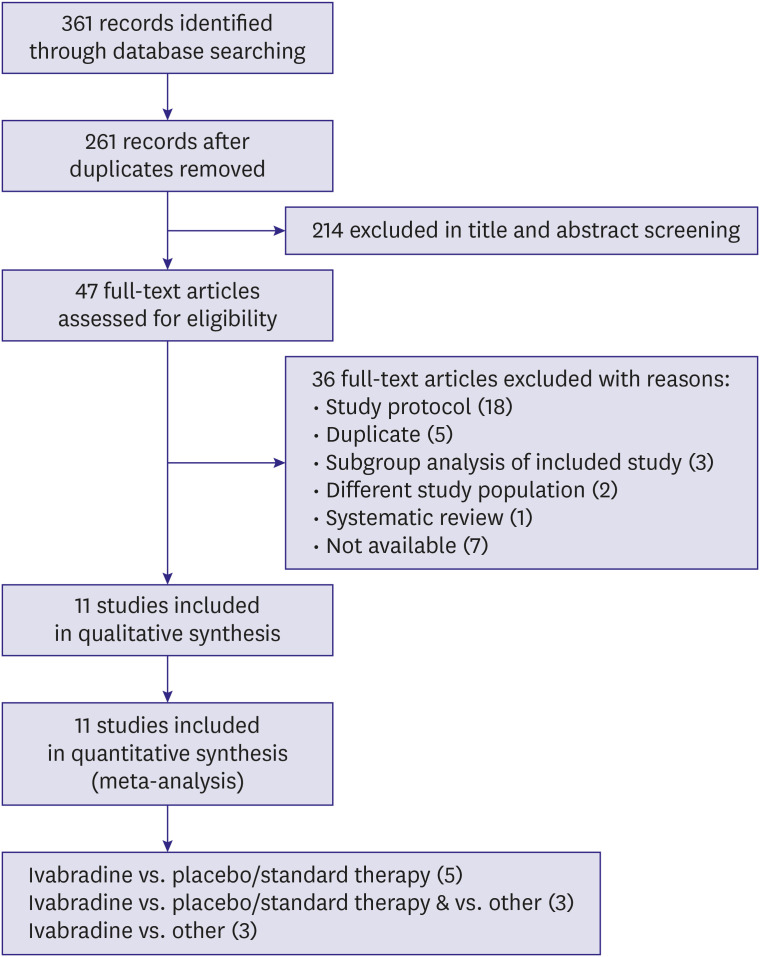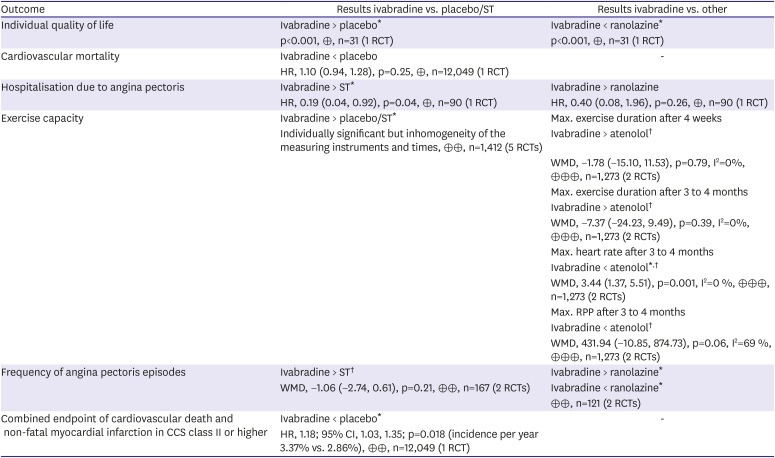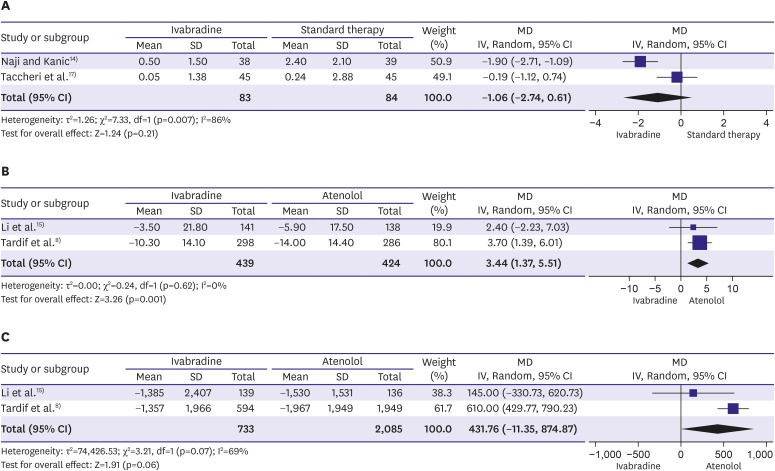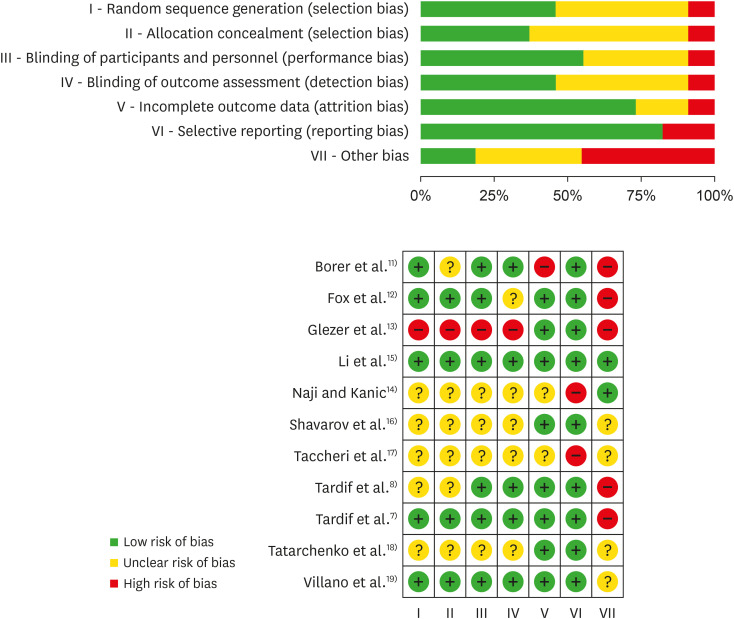1. Fox K, Garcia MA, Ardissino D, et al. Guidelines on the management of stable angina pectoris: executive summary: the task force on the management of stable angina pectoris of the European Society of Cardiology. Eur Heart J. 2006; 27:1341–1381. PMID:
16735367.
2. Task Force Members. Montalescot G, Sechtem U, et al. 2013 ESC guidelines on the management of stable coronary artery disease: the task force on the management of stable coronary artery disease of the European Society of Cardiology. Eur Heart J. 2013; 34:2949–3003. PMID:
23996286.
5. Picano E, Alaimo A, Chubuchny V, et al. Noninvasive pacemaker stress echocardiography for diagnosis of coronary artery disease: a multicenter study. J Am Coll Cardiol. 2002; 40:1305–1310. PMID:
12383579.
6. Fox K, Ford I, Steg PG, Tendera M, Ferrari R. BEAUTIFUL Investigators. Ivabradine for patients with stable coronary artery disease and left-ventricular systolic dysfunction (BEAUTIFUL): a randomised, double-blind, placebo-controlled trial. Lancet. 2008; 372:807–816. PMID:
18757088.

7. Tardif JC, Ponikowski P, Kahan T. ASSOCIATE Study Investigators. Efficacy of the I(f) current inhibitor ivabradine in patients with chronic stable angina receiving beta-blocker therapy: a 4-month, randomized, placebo-controlled trial. Eur Heart J. 2009; 30:540–548. PMID:
19136486.

8. Tardif JC, Ford I, Tendera M, Bourassa MG, Fox K. INITIATIVE Investigators. Efficacy of ivabradine, a new selective I(f) inhibitor, compared with atenolol in patients with chronic stable angina. Eur Heart J. 2005; 26:2529–2536. PMID:
16214830.

9. Ye L, Ke D, Chen Q, Li G, Deng W, Wu Z. Effectiveness of ivabradine in treating stable angina pectoris. Medicine (Baltimore). 2016; 95:e3245. PMID:
27057864.

10. Mengesha HG, Weldearegawi B, Petrucka P, Bekele T, Otieno MG, Hailu A. Effect of ivabradine on cardiovascular outcomes in patients with stable angina: meta-analysis of randomized clinical trials. BMC Cardiovasc Disord. 2017; 17:105. PMID:
28454527.

11. Borer JS, Fox K, Jaillon P, Lerebours G. Ivabradine Investigators Group. Antianginal and antiischemic effects of ivabradine, an I(f) inhibitor, in stable angina: a randomized, double-blind, multicentered, placebo-controlled trial. Circulation. 2003; 107:817–823. PMID:
12591750.
12. Fox K, Ford I, Steg PG, et al. Ivabradine in stable coronary artery disease without clinical heart failure. N Engl J Med. 2014; 371:1091–1099. PMID:
25176136.

13. Glezer M, Vasyuk Y, Karpov Y. Efficacy of ivabradine in combination with beta-blockers versus uptitration of beta-blockers in patients with stable angina (CONTROL-2 study). Adv Ther. 2018; 35:341–352. PMID:
29508153.

14. Naji F, Kanic V. Pretreatment with ivabradine reduces periprocedural myocardial injury and infarction in stable ischemic patients undergoing coronary intervention. Eur Heart J. 2014; 35:127–128.
15. Li Y, Jing L, Li Y, et al. The efficacy and safety of ivabradine hydrochloride versus atenolol in Chinese patients with chronic stable angina pectoris. Pharmacoepidemiol Drug Saf. 2014; 23:1183–1191. PMID:
24757084.

16. Shavarov AA, Kiiakbaev GK, Kobalava ZhD. A possibility to interchange heart rate-slowing therapy with ivabradine and atenolol in patients with stable angina pectoris. Ter Arkh. 2013; 85:77–83.
17. Taccheri T, Calcagno S, Carnesale R, et al. Comparison of the efficacy and tolerability of ivabradine vs ranolazine vs standard medical therapy in patients of chronic stable angina pectoris despite coronary percutaneous revascularization. Eur Heart J. 2014; 35:323.
18. Tatarchenko IP, Pozdniakova NV, Biriuchenko MV. Comparative efficacy of ivabradine and atenolol in correction of clinical and functional parameters in patients with stable effort angina. Kardiologiia. 2008; 48:60–61.
19. Villano A, Di Franco A, Nerla R, et al. Effects of ivabradine and ranolazine in patients with microvascular angina pectoris. Am J Cardiol. 2013; 112:8–13. PMID:
23558043.

20. Higgins JP, Green S. Cochrane handbook for systematic reviews of interventions. Version 5.1.0 [Internet]. London: The Cochrane Collaboration;2011. cited 2018 Jul 6. Available from
http://www.cochrane-handbook.org.
21. The Cochrane Collaboration. Review Manager (RevMan). 5.0. Copenhagen: The Cochrane Collaboration;2008.
22. Spertus JA, Winder JA, Dewhurst TA, et al. Development and evaluation of the Seattle Angina Questionnaire: a new functional status measure for coronary artery disease. J Am Coll Cardiol. 1995; 25:333–341. PMID:
7829785.

23. EuroQol Group. EuroQol--a new facility for the measurement of health-related quality of life. Health Policy. 1990; 16:199–208. PMID:
10109801.
25. Kaski JC, Gloekler S, Ferrari R, et al. Role of ivabradine in management of stable angina in patients with different clinical profiles. Open Heart. 2018; 5:e000725. PMID:
29632676.

26. Werdan K, Perings S, Köster R, et al. Effectiveness of ivabradine treatment in different subpopulations with stable angina in clinical practice: a pooled analysis of observational studies. Cardiology. 2016; 135:141–150. PMID:
27333284.

27. Fox K, Ford I, Steg PG, et al. Relationship between ivabradine treatment and cardiovascular outcomes in patients with stable coronary artery disease and left ventricular systolic dysfunction with limiting angina: a subgroup analysis of the randomized, controlled BEAUTIFUL trial. Eur Heart J. 2009; 30:2337–2345. PMID:
19720635.

28. Borer JS, Swedberg K, Komajda M, et al. Efficacy profile of ivabradine in patients with heart failure plus angina pectoris. Cardiology. 2017; 136:138–144. PMID:
27614723.

29. Amosova E, Andrejev E, Zaderey I, Rudenko U, Ceconi C, Ferrari R. Efficacy of ivabradine in combination with beta-blocker versus uptitration of beta-blocker in patients with stable angina. Cardiovasc Drugs Ther. 2011; 25:531–537. PMID:
21830063.

30. Ferrari R, Camici PG, Crea F, et al. Expert consensus document: a ‘diamond’ approach to personalized treatment of angina. Nat Rev Cardiol. 2018; 15:120–132. PMID:
28880025.








 PDF
PDF Citation
Citation Print
Print




 XML Download
XML Download